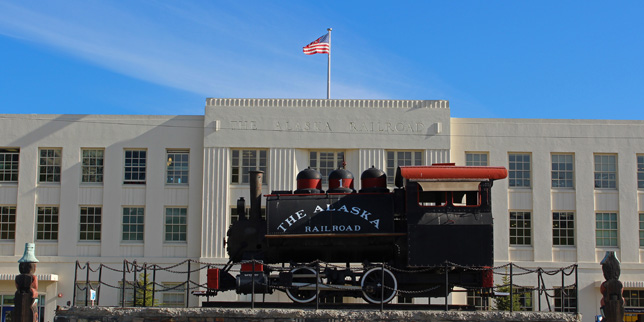History

Alaska Railroad History
By the early 1900’s, the territory of Alaska was already rich with natural resource discoveries, including coal, gold and other minerals. What was needed was a way to transport these valuable goods from interior Alaska to the tidewater. In 1903, a privately held company called the Alaska Central Railway began laying track north from the ice-free coastal town of Seward. By 1909, the company had built about 50 miles of track before going bankrupt and reorganizing as the Alaska Northern Railway. This company added another 20 miles of track, ending near the present day location of Girdwood. Goods were shipped along the railway from Seward, then loaded into small boats and floated up the Turnagain Arm, but no additional track was added.
In 1914, the United States Congress authorized construction of 470 miles of rail line from Seward to Fairbanks. In 1915, the 70 miles of existing track was purchased from Alaska Northern, and Anchorage was established as a “tent city” railroad construction camp, as well as headquarters for the new Alaska Railroad Corporation. The budget for the new railroad was $35 million, although the final cost would be nearly twice that amount. At its peak in 1917, the railroad employed over 4,500 construction workers. President Harding marked the official completion of the railroad by driving in the final “golden spike” in the town of Nenana on July 15, 1923.
The railroad continued to play an important role in Alaska during World War II, moving materials and supplies needed for the war effort in Alaska. This included the construction of new military bases in Anchorage and Fairbanks. During this time, two long tunnels were built to connect the mainline with the additional ice-free port of Whittier. After the war ended, the railway, suffering from the heavy use, received a well needed $100 million renovation and upgrade.
On March 27, 1964 the Alaska Good Friday earthquake caused nearly $30 million dollars in damage to the Alaska Railroad, with the greatest impact focused south of Anchorage. The magnitude 9.2 quake, the largest ever recorded in North America, wiped out rail facilities in Whittier and Seward, twisted tracks, and damaged bridges up and down the line.
In May of 1984, the railroad began pulling privately owned “superdome” train cars for a company called Tour Alaska. This started a trend, and today there are over 25 custom built full dome railcars cars in use, including the privately owned McKinley Explorer and Wilderness Express as well as the Alaska Railroad’s own GoldStar domes.
In January of 1985, the State of Alaska purchased the railroad from the federal government for $22.3 million, investing an additional $70 million in the coming years for needed repairs and improvements. In 2000, the longer Whittier tunnel was upgraded to handle alternating own-way rail and vehicle traffic. During the Clinton administration there were discussions about the possibility of connecting the “lower 48” with Alaska by rail, but little progress has been made. Expansion of rail service in the MatSu Valley and from Fairbanks to Delta Junction is in the works.
Today, the Alaska Railroad continues to play a critical role in moving natural resources, freight and passengers in Alaska’s interior and Southcentral regions.